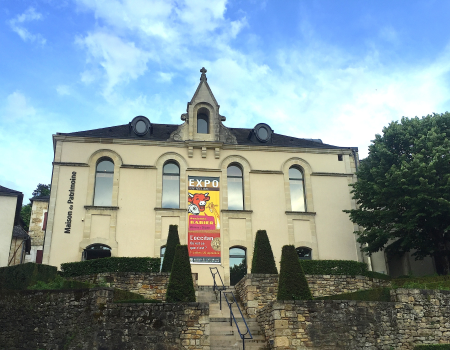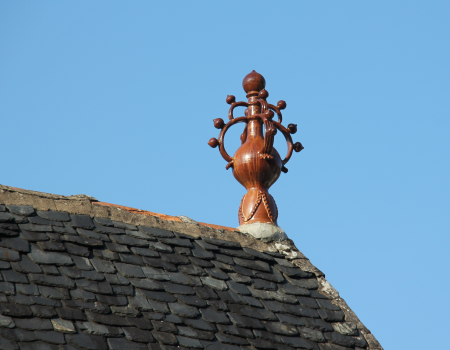Sightseeing in and around Terrasson
Terrasson is a small town with a long history. Largest tourist attractions are the Les Jardins de L'Imaginaire, a visit to the Maison du Patrimoine, the église Saint Sour and artisan shops will complete a stroll through the old town.
In and around Terrasson a number of walks (promenades) and hikes(randonnées) are maintained by the Dordogne department.Terrasson is also the starting point of a new long distance trail through the Vézère valley; in the footsteps of the Men of Lascaux.
The Coly valley is Terrasson's backyard find hiking, biking, horse riding and kayaking opportunities through our 'Active exploring page' here.
Walking in Terrasson (Promenades)

Join the historic circuit tour or evening walk of the tourism office of Terrasson or explore the old town's streets by yourself. Stroll through alleys, and squares, visit the sarcophagus, cluzeau, octroi, and take in the scenery from the ramparts. Choose one of the 'circuits':
| Walks around Terrasson | ||||
|---|---|---|---|---|
| > | The Discovery Circuit | |||
| > | The Fountains Circuit | |||
The discovery circuit starts from the tourism office and passes the 11th century 'old bridge' (1), just across on the left you will find the little 'octroi' building with its weighing bridge and scale. Cross the Avenue Charles de Gaulle and walk through some of Terrasson's oldest streets the Rue Margontier that follows the natural contour/slope up the Malpas cliff.






At the end of the Rue Basse turn left and walk to the Place the Genouillac (9), the former cattle market positioned on the space ones occupied by a Merovingian villa (6th century) that was burned down by the Normans in the 8thcentury. A display building allows you to see some stone Merovingian sacrophagus, and the old fountain of Saint Julien still marks the square. The restaurant building on the other side of the street was build on the fundaments of the old monastery, to your right you will find the Château Jeanne d'Arc, which today hosts the second tourist office and starting point for guided visits of the Jardins de L'Imaginaire (5).
From here you walk in the direction of the church up the medieval road, with the small Place de Guingois on the left and the old Rue de la Marzelle to the right. This alley will take you to the old truffle market. Continue to walk up and you will get to the Place the Bouquier with the Bouquier house, and the cluzeau on your left. Across the square you have the stairs up to the church, or halfway up to the left, will take you to the outer ramparts (3). Walking over the ramparts you can choose to walk the wooden walkway down on the left, walk straight passed the restaurant to the Malpas gate, or take the stair up to the former 'inner sanctum'.
The Place Abbaye has retained its religious buildings to the north of the L'église Saint Sour (4), buildings to the front made space for the stairway and gardens that today connect to the Bouquier square, to the south (up hill) you can visit the Maison du Patrimoine (6). There are a few ways to get to the old Rue Haute, down from the Place Abbaye on the south side and then up the small tunnel or through a few alley ways from the Maison du Patrimoine. This was the old road to Sarlat and is guarded by the Château Brossard de Marcillac, this group of buildings, and the ones a little further up hill have been lovingly restored. To go back to the town, take the river stone stairway downward is very easy.
Les Jardins de L'Imaginaire(5)
Discover 2,000 rosebushes; 20,000 perennials; 2,500 box hedges; 120 sprays of water; more than 150 plant species; 8,000 trees and bushes including rare species; terraces; a theatre-in-the-green; a hedge tunnel; woodlands; a viewpoint; water gardens; and many other features on these six hectares of land overlooking the Vézère river in a contemporary garden stretching over 6 hectares. 13 natural landscapes, as surprising as they are enchanting, recount the history of gardens since the Roman period. Here you'll find the immutable elements of the world's gardens: water, wind movement, plants, perspectives and more. The richness of this garden needed to be experienced with five senses. In particular, that the concept of the diversion of surging water nourishes the whole earth. And the guide will tell you the ideology behind each design. Adults € 7.50.
The Maison du Patrimoine(6)
In the upper part of the old town the heritage house is housed in a former convent to help to preservation and presentation of Terrasson's (and the wider black Perigord's) cultural heritage. It also tries to be a cross-road between art and heriage. It does so with a general exhibition on the ground floor, with the precious Roman Mosaic floor at its heart. The first floor has changing exhibitions by local artists or historical and heritage themes. For example, the first half of 2016 saw an exhibition on French artist Benjamin Rabier: 'The man who made animals (and people) laugh”. July-August-September 2016 and in 2017 saw the exhibition De la belle époque... aux années folles with works of Georges 'Sem' Goursat. On the top floor a permanent exhibition dedicated to he towns 'Epis de faitage', showcases reproductions that allow the visitor to come up close with these typical ornaments that grace the roof endings of old town buildings.
L'église Saint Sour(4)
In the 8th and 9th centuries, the Vikings penetrated the region from the Vézère river and destroyed the first monastery. The Benedictines decided to build this abbey church on the highest part of the hillside. The abbey church is fortified with ramparts along the cliff and was placed under direct authority of Pope Alexandre III in 1165 and continued to flourish under the protection of the king of France after 1229. Early in the 14th century extensive rebuilding took place.
During the Hundred Years' War (1350) the church, abbey, town and even part of the old bridge were destroyed by the English. By the end of the 15th century reconstruction starts and was finished by 1540, just in time for the Wars of Religion during which it was pillaged and burned down by Catholics and Huguenots alike (1569), the Huguenots destroy the grave of Saint Sour. In 1575 a renegade 'comte de Martinengue' seeks refuse in the ruins, but is defeated leaving little but a ruin.
Rebuilding work took place in the 17th and 18th centuries, but it was not till the 19th century that the restoration was completed with the help of architect Chevals, who also restored Rocamadour. Thus the new church was consecrated in 1889. Recently a six year long restoration was completed. In the church a reliquary said to contain Saint Sour's bones and a statue representing him can be found. A painting of Saint Julien de Brioude, the roman soldier and early convert to Christianity martyred in 304 AD.








